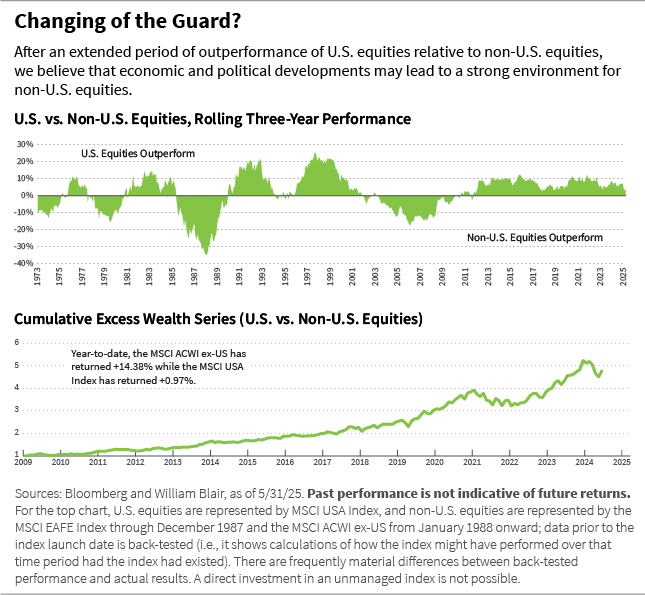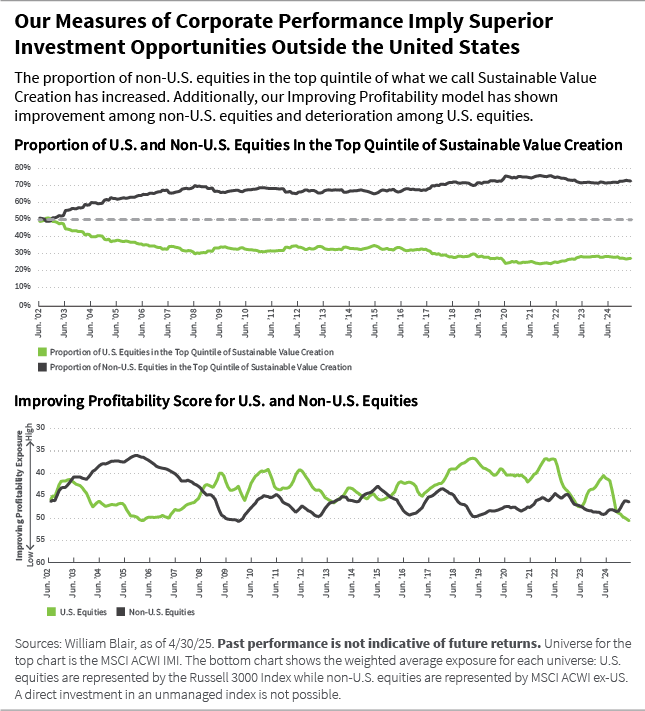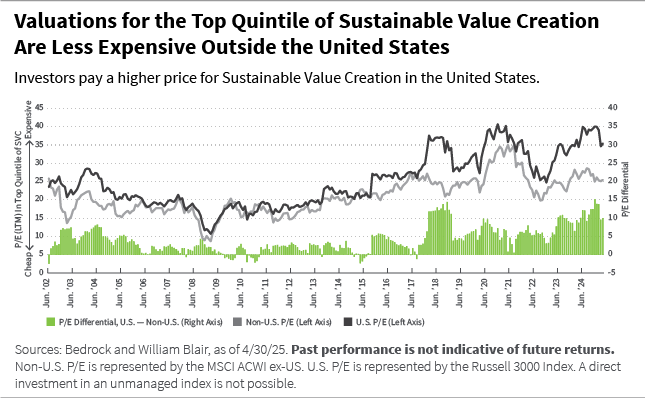July 15, 2025 | Global Equity
Three Pillars of Non-U.S. Investing Revisited

Five years ago, in “Three Pillars of International Investing,” we explained why we think investors should consider allocating to non-U.S. equities. The crux of our argument was threefold.
First, company-specific factors, including what we call Sustainable Value Creation (which is essentially strong corporate performance), are increasingly more important than country-specific factors, and as we look across our opportunity set of global equities, we find that more companies that deliver strong Sustainable Value Creation are found outside the United States.
Second, expectations for earnings growth and return on invested capital (ROIC) have become more favorable outside the United States—and our outlook for growth in key industries suggests accelerating demand and emerging business models abroad.
Third, the regulatory environment outside the United States is more conducive to the proliferation of disruptive business models.
We find that new forces are emerging that underpin why the year-to-date outperformance of non-U.S. equities is a movement—not just a moment.
While each of these pillars remains a relevant argument as to why we believe investors should allocate to non-U.S. equities, we find that new forces are emerging that underpin why the year-to-date outperformance of non-U.S. equities is a movement—not just a moment. See below.

Time for a Refresh?
For more than two decades, the fishing pond of high-quality growth investments has been expanding such that the opportunity set outside the United States is now larger than inside the United States. This is likely non-controversial given that the percent of nominal global gross domestic product (GDP) outside the United States has grown from 68% in 2011 to over 73% currently.
In addition, our quantitative indicators such as Improving Profitability—which tracks directional shifts in corporate profitability—are accelerating outside the United States while showing greater volatility and deterioration within the United States.
The charts below illustrate.

As institutional investor interest in developed non-U.S. and emerging markets (EM) equities has grown, companies in these jurisdictions have professionalized their operations and implemented a shareholder return focus that has resulted in a higher-quality investment opportunity set.
Additionally, within our quality growth opportunity set, we see more attractive valuations outside the United States. This is illustrated in the chart below, which exhibits the valuation difference between U.S. and non-U.S. companies that are in the top quintile of Sustainable Value Creation.

As we entered 2025, the gap between the United States and the rest of the world—in economic growth, corporate profit margins, and relatedly, equity valuations—was at or near a historic high. While the performance gap between U.S. and non-U.S. equities has historically been cyclical, the latest divergence was underpinned by a distinct combination in the United States of economic dynamism, leadership in technology innovation, and strong institutions.
Today, however, shifts in policy direction under the current U.S. administration, combined with the ambitions and commitments of a galvanized European Union (EU), suggest we may on the precipice of change.
What’s different now is that the growth differential between the United States and the rest of the world is narrowing, as shown below. In a low-growth environment, we have observed that investors have been willing to pay a premium for U.S. earnings growth, which has consistently outpaced non-U.S. markets since the global financial crisis. But that premium may no longer be justified.

We believe several forces—tariffs that weigh on U.S. household disposable income, shifts in fiscal and economic policy abroad, and evolving macroeconomic conditions—could compress growth differentials between the United States, Europe, Japan, and China. As a result, the valuation per unit of growth equation looks increasingly favorable for markets outside the United States, potentially supporting greater capital flows into non-U.S. equities. We will explore these forces in the next blog in this series, “Three Global Shifts That Favor Non-U.S. Markets."
Alaina Anderson, CFA, partner, is a portfolio manager on William Blair’s global equity team.

Non-U.S. Investing In a Fragmenting World Series
Part 1 | Three Pillars of Non-U.S. Investing Revisited
